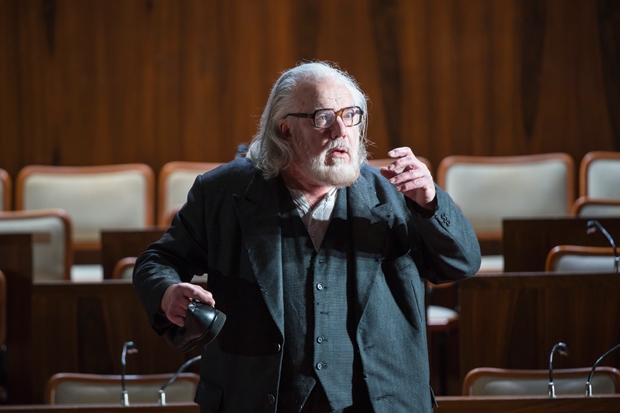On paper, Moses und Aron might seem intractable and abstract: a 12-tone score setting a libretto that meditates on God, faith, the essential inadequacy of language to express the ineffable, and a great deal more. Put it in the theatre, as Welsh National Opera has done as the first part of its ‘Faith’ mini-season, and it’s an overwhelming experience, compelling because of, rather than in spite of, its subject matter and musical methods.
And just over 80 years after Schoenberg stopped work on it (he left it incomplete, having written only a fragmentary text for the third act), its themes are as pertinent as ever. Political parallels with a people longing for quick fix, tangible solutions to their woes don’t need to be spelt out; but, after a week in which the opera world seemed intent on tearing itself apart because of the manner in which ideas regarding a singer’s on-stage persona were translated into words, there were also additional ironies. One of these, however, was the unfortunate fact that Rainer Trost, due to sing Aron, who gives voice to his brother Moses’s ideas, was rendered voiceless by illness. His understudy, Mark Le Brocq, jumped in at the last minute to save the day, singing heroically and brilliantly realising the character — in Jossi Wieler and Sergio Morabito’s updated production — as a tracksuited, greasy-haired but wily and charismatic speaker. As Moses, John Tomlinson is a towering but vulnerable presence, booming out his Sprechgesang with authority, while also capturing the character’s impotence. Richard Wiegold’s Priest leads an excellent secondary cast.
But Moses und Aron is as much about the people as their prophets, and no praise can be high enough for the vast WNO Chorus, singing and speaking their intricate, multiple parts with total command and overwhelming power, each individual helping to create a fiercely realistic, threatening and fickle mob (the directors must also take a great deal of credit here). Presiding over it all, Lothar Koenigs inspires his orchestra to playing of searing intensity, pinpoint detail and, particularly in the aching violin lines, melting beauty.
Less entirely convincing is Wieler and Morabito’s production, originally seen in 2003 in Stuttgart, where the two are respectively Intendant and chief dramaturg, and revived here by Jörg Behr. They place the action within an auditorium, a sort of lecture theatre or council room for Act 1, which turns into a cinema in Act 2, the Golden Calf becoming unseen cinema projections — a reference, presumably, to Schoenberg’s own forlorn hope that film would prove a source of cultural renewal — which inspire the final orgy before Moses’s return. It is a clever and telling solution, which implies a powerful critique of film’s role in politics.
The production’s own ill-defined beginnings and endings make us uncomfortably complicit, but elsewhere it feels less convincing, not least in leaving Act 1’s miracles to the imagination and dressing the chorus in the sort of Balkan poverty chic that was de rigueur a decade ago. Nevertheless, no one interested in 20th-century music — or indeed in the 20th century or music more generally — should miss this. (After Cardiff it goes on tour to Birmingham and Covent Garden.)
Patrice Chéreau’s last operatic production was an Elektra unveiled in Aix-en-Provence last summer, only a matter of months before his death in the autumn. In the midst of all the controversy surrounding its Intendant-elect, Alexander Pereira, La Scala this month became the last place that the production could be seen with more or less the cast that had worked on it with the director, and therefore with his official imprimatur (a DVD of the Aix performance has also just been released). Admittedly things might have become diluted in Vincent Huguet’s revival, but it’s sadly a rather provisional-feeling affair. It looks as though it could be several decades old, with few ideas — extras constantly milling about, subsidiary characters forming part of a palace community, and communication effected largely through notes delivered by hand — that don’t really add up. Richard Peduzzi’s dull sets (massive and grey) are dully lit by Dominique Bruguière.
The terrific principals are often left to their own devices, and too often plonked, with little regard for acoustics, somewhere in the middle, halfway up-stage. The impact of Evelyn Herlitzius’s Elektra (surely one of the greatest operatic impersonations to be witnessed anywhere these days) is severely dampened. Adrianne Pieczonka pours out plenty of warm, brightly lyrical tone as Chrysothemis, but Waltraud Meier is underpowered as Klytämnestra. René Pape is a solid, luxuriously sung Orest. The rest of the cast, including in Donald McIntyre and Franz Mazura veterans of some genuinely classic Chéreau productions, is generally excellent. Esa-Pekka Salonen finds plenty of interesting details in the score, but the playing of the La Scala orchestra is often too loud and unrefined.






Comments